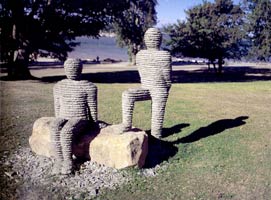|
Since 1985, Vaadia's sculptures have been
identified with the concept, matter, method and the artistic ideas concerning
a specific person, a man, a woman, a mother, and a child.
His works are made of slate or bluestone
slices stacked on top of each other. The bluestone and slate was revealed
to him by long observation of urban pavements in Soho. Some of this
work was translated into bronze. Born in 1951 in Gat-Rimon, Petach-Tikva,
Israel, he attended the sculpture workshop of the sculptor Moshe Shternshus
at the Avni Art Institute on the 2nd level, Eilat St., Jaffo. It was
a period in which sculpture and painting were at their peak. This is
where I met him.
During the 70's, Boaz Vaadia used hair,
pebbles, and cats as his models to be later transformed (translated)
into wax. These were exhibited at Blatman Gallery, Julie M. Gallery
and at Tel-Hai events in Israel.
In 1975, Boaz Vaadia received a grant
from The America-Israel Cultural Foundation and decided to pursue his
career in New York. He rented a loft at 48 Mercer St., Soho, an abandoned
area which later became a popular and sought after area in the New York
art scene. 1975 was considered a turning point in New York - moving
away from minimalistic art and into other trends - resulting in the
opening of many galleries in a high density area. The low rents attracted
gallery owners and artists to the area that had become a pilgrimage
center. The New York scene in its making enabled him to observe, to
grow, and to be a meaningful part of life in Soho. Settling in this
area determined his artistic future and destiny.
His first showings were held at the Hundred
Acres gallery in 1976 and later in 1986 at the O.K. Harris Gallery with
his figurative work. Art guru Ivan Karp's galleries were the address
for all artists who dreamt to exhibit in New York and to gain some worthwhile
recognition. The exhibition at the Hundred Acres gallery in 1976 had
a display of a stone slingshot in which leather strips, pebbles, cow
skin and hair were mixed. The young artist worked his way up with the
persistence characteristic of artists who believed in their work and
were totally dedicated to do just that.
All of Vaadia's stone sculptures since
1985 to date are of one mold: specific people perhaps, a longing for
the family. The father or the mother image possibly interwoven deep
in the artist's soul. The sculptures are constantly repeated: carved
outlines of bluestone slices - slices piled up horizontally to form
a graded design of a person's shadow, the image. A symmetrical dialogue
between the slices of stone and the image of man.
The primeval stone stemming as far back
as the creation of the solid universe lends itself to the description
of the temporary stage of the image whispering 'from earth you came
and to earth you will return.' The shadow is just that, a shadow, with
no identifying details, facial expressions, or bodily tension. The image
is always presented in a positive comfortable position expressing presence,
stability and tranquility. The work does not pretend to immortalize
the struggle between individuals or any other struggle, with each image
capturing its own physical space, neither threatening nor overpowering
- like the presence of people in a park. Very similar to the images
painted by George Seurat, the images are very general and physical -
as if the sculptures were aware of their eternal stone structure. The
stone serves the images in their delicate mortal state.
In the history of sculpture, the human
body serves the most central axis. The body as a concept to capture
Gods, religious sculptures, rulers, Pharaohs, beliefs, and beauty.
Michelangelo, in his series "The Slave",
left the human body tarnished, unfinished, hidden in stone, leaving
it to the viewer to extract it from the stone stage to the human body
stage, and fully participate in the transformation and emergence of
body from stone. Auguste Rodin revives the stone into a breathing living
body. Picasso dismantles it, blows it up, or creates a frontal exaggeration
. Giacometi elevates the stone, aiming towards the spiritual and heavenly.
Aristied Maiolle admires the feminine figure, polishes it into stone
and bronze to the ultimate passionate realism.
Vaadia's sculptures remain simply human,
democratic, secular, not pretentious and not elevating the person, without
constructing classes. The sculpture is simply present in the garden,
in the park, unnoticed, passing, almost unseen, with arms and legs modestly
attached to the body unlike other figurative sculptures with arms and
legs spread apart.
In this age of fast communication many
have the tendency to rush and be there as if their absence means they
do not exist. Boaz Vaadia's way represents the inner reflection of an
artist who has submitted himself to his work with a persistence which
should be admired - rushing nowhere, loyal to his conception of his
sculptures and seemingly unidentified with any current contemporary
trend which may force artists to draw a line.
The value of his work is measured by the
internal serenity, the total devotion to return again and again to the
human being which is all shadow and totally anonymous; the invisible
person, the non existing, that is blended and supported by nature's
open spaces gaining elevation and growing from stone into sculpture.
Translated into English by Dalia Ayalon
Sinclair
_____________________________
|
